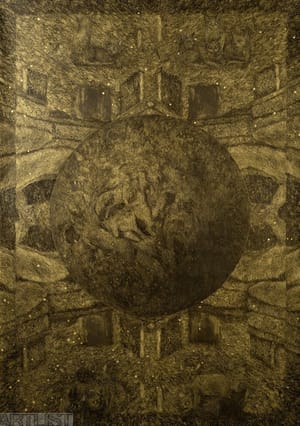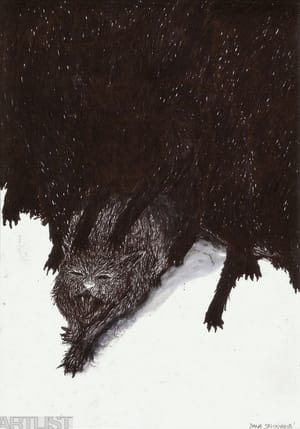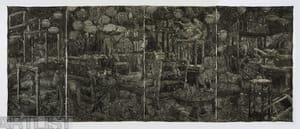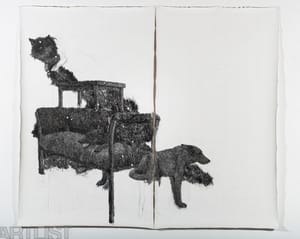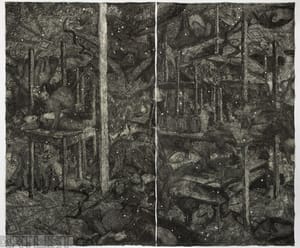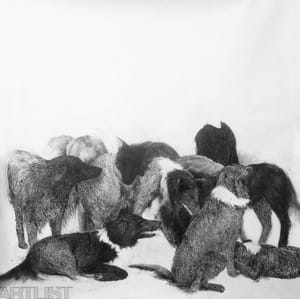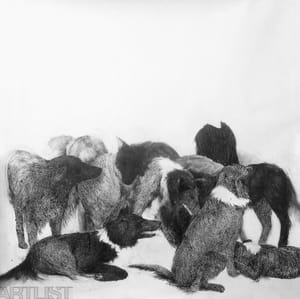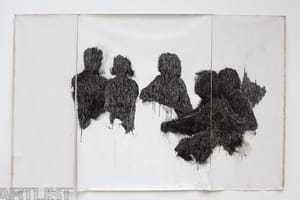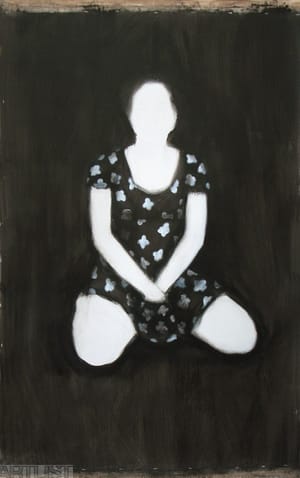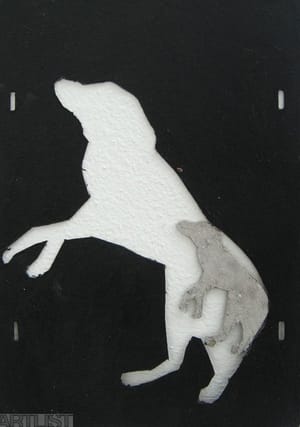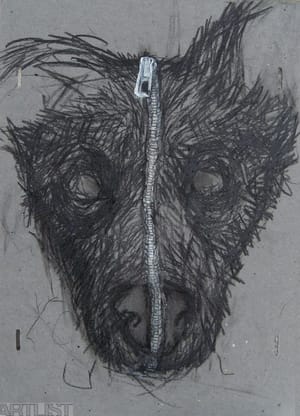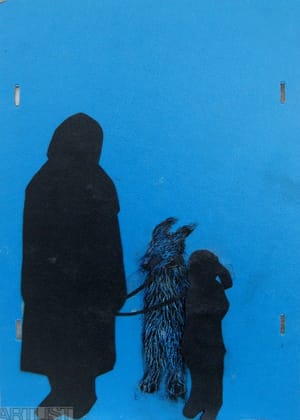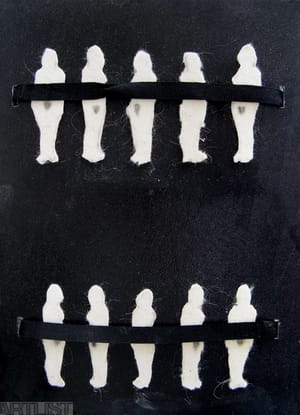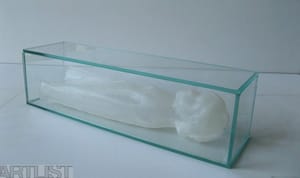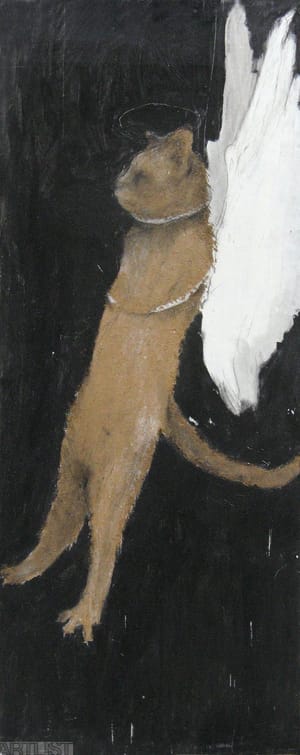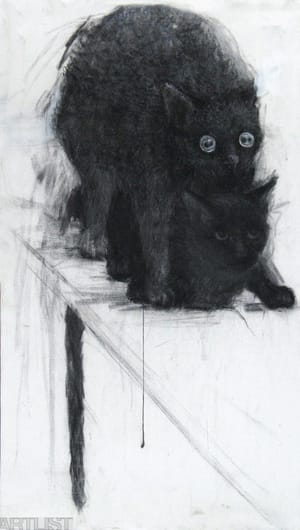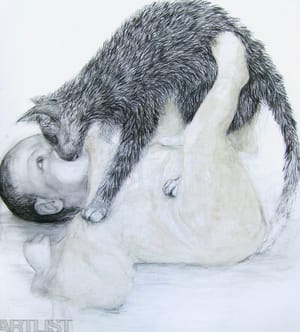- First Name
- Dana
- Surname
- Sahánková
- Born
- 1984
- Birth place
- Praha
- Place of work
- Praha, Všenory
- Website
- www.sahankova.com
- Keywords
- CSU Library
- ↳ Find in the catalogue
About artist
Dana Sahánková ranks amongst the most prominent members of the youngest generation, that of the 2000s, for whom she has updated the medium of drawing. It was in drawing that Sahánková acquired an expressive potential consisting of a distinctive iconography and poetics, which cannot be perceived and thought of without authentic content that captures and reveals. The transition from study drawing to her own style took place in 2006–08 while she was still at the drawing studio at AVU in Prague led by professor Jitka Svobodová, whose specialist assistant was Jiří Petrbok. At that time, the theme of an independent figure, usually a child, appeared more and more, along with animals. The child in relation to animals was confronted with the first experiences that impact and change their consciousness. Sahánková placed the experiential erosion resulting from the obverse side of knowledge on the polarities of innocent play and violence. An anagram of play as a testing tool of cognition, and a pet that changes from a toy into an object of research as well as a model of birth and death, offers a report on the stage of a child’s socialisation. Natural cycles are viewed as a cruel world (e.g. the reproduction of cats), a ritual of concern for survival as a personified relationship of dominance and sacrifice (the cycle Oběti / Victims, 2008). That which formed the framework of the home (child, animal, family) irreversibly changes its features.
In 2009–10 Sahánková expanded the purview of her drawings to include more complicated scenes and compositions. These naturally ensued from the more complex, more ambiguous relational structures that she was beginning to take an interest in at the time and often involved questions relating to the status of a gender or species-related collective and its internal differences and transformations – families and packs (Smečka / Pack, 2010; Rodina / Family, 2010). The level of the hierarchisation of relationships and their transformations within human and animal communities was analogically manifest in a solution to the relationship of drawing itself to the pictorial format, and the pictorial format to the wall. It is as though the artist is examining the very process of “searching for a framework” under the influence of a change in consciousness on the basis of lived experience in time. The framework of the background, i.e. the family, loses its obviousness here, just as the pictorial framework loses its automatic circumscription and becomes complicated. Hence the motif of the “furry family”, which would be an indivisible whole that, however, begins to be perceived as an anomaly: hence also the overlapping or erasure (disappearance) of motifs as metaphors of an old, fading consciousness that is replaced by a new knowledge. This topic culminated in the artist’s diploma work entitled Soužití / Coexistence (2011). The metaphysical anxiety provoked by the coming changes is reflected in the fragmentation of motifs and their obscuration by the process of merger and accretion. On the contrary, a liberating moment is the increasingly accentuated pure white surface of the paper and canvas, opening the space for the “other” and the “new”.
In 2012–14 Sahánková approached the negation of the “home” as a space “without distinction”, in which the spatial and symbolic dimensions (exterior/interior; outside/inside; wild animals in the setting of an apartment, etc.) intersect. Wild nature grew through the framework of a preserve, and with it a new anxiety, that of freedom. This was also clear in the cycle Vyslanci chaosu / Envoys of Chaos (2012), which examines and intensifies the discrepancy in motives for confrontation and conflict. The artist pays close attention to the willed deformation of animals during intimidation and attack, as well as during defence or the signalling of submission. By observing the animal world, Sahánková acquires the experience that phenomenology, especially that of Maurice Merleau-Ponty, requires for the revival of human percipience. The drawing itself becomes an attitude, a gesture, teeth, nails and claws.
Large compositions turn into darkly unified “memory landscapes” reminiscent of storehouses of consciousness, a place in which a large amount of unprocessed experience, information and data is accumulated. The surface only shines in spots here, like the stars shine in the sky or the apertures of perforations in the dark (Bez názvu IV-IV / Untitled IV-IV, 2012-13). In front of the viewer hangs a picture like a curtain totalising its own weighted past. Only the vertical joints indicate that a new space is opening behind the imaginary curtain. A space of personal freedom, for the discovery of which it is important and determinative that we ourselves decide to step forward and open the curtain.
- Author of the annotation
- Petr Vaňous
- Published
- 2015
CV
Education:
2005 - 2011 Academy of Fine Arts in Prague, atelier Jitka Svobodová
2009 New Media Studio 2 Veronika Bromová
2008 Ecole Nationale Superieure d'art, Dijon
2005 Faculty of Architecture, Czech Technical University, Prague
Awards:
2012 finalist Price of critics for young painters, Galerie Kritiků, Prague
Exhibitions
- Solo exhibitions
-
2014
Mezi podlahou a stropem, Galerie Dole, Ostrava
Odraz světla, odraz tmy, Galerie Altán Klamovka, Praha
2013
INFP(snílek)/INFJ(umělec), Galerie OFF/FORMAT, Brno (s Nikolou Čulíkem)
Cave bestias, Galerie Kaple, Valašské Meziříčí
2012
Unus mundus, Galerie Půda, Jihlava
2011
Nadaleko, Galerie 35m2, Praha (s J. Střížkovou)
2010
Chtěla bych to vědět, Dům U Zlatého prstenu, GHMP, Praha
- Group exhibitions not included in ARTLIST.
-
2015
Jehla v kupce sena, Topičův salon, Praha
2014
Drak se probouzí, Palác Kinských, Národní galerie, Praha
REkonstrukce, Galerie Emila Filly, Ústí nad Labem
NULLA DIES SINE LINEA, Galerie Emila Filly, Ústí nad Labem
2013
Já - je někdo jiný, Galerie kritiků, Praha
Ich - ist ein anderer, Galerie VNG AG, Leipzig, Německo
2012
6. Zlínský salon mladých, Dům umění, Zlín
Kurace / Kresby na lodi, Galerie Avoid, Praha
Cukr & Bič, Městská galerie, Litomyšl
Second season, AMoYA, Praha
5. ročník Ceny kritiky za mladou malbu (finalisté), Galerie kritiků, Praha
2011
Česká malba generace nultých let 21. století, Wannieck Gallery, Brno
Diplomanti AVU, Karlin Hall, Praha
2010
Šťavnatý odkaz, Trafo galerie, Praha
2009
Sériová monogamie, Galerie AVU, Praha
2008
Pacientův pacient, Galerie Jána Šmoka, Jihlava
2007
11 + 2, Dům umění, Opava
- Collections
- Collection of Contemporary Art, Richard Adam Gallery, Brno
Monography
- Monography
Vaňous, Petr: Jehla v kupce sena (katalog výstavy), Topičův salon, Praha 2015 Mikolášek, Martin: Mezi podlahou a stropem, Galerie Dole, Ostrava 2014 Navrátil, Ondřej: Nikola Čulík – Dana Sahánková/ INFP (snílek) INFJ (umělec), katalogová pozvánka, Galerie OFFormát, Brno, 2013 Ptáček, Jiří: Dana Sahánková (heslo), katalog VI. Zlínského salonu mladých, 2012 Čiháková Noshiro, Vlasta (Ed.): Cena kritiky za mladou malbu 2012 (katalog), Galerie Kritiků, Praha 2012
- Articles
Vaňous, Petr: Kouzlo a hrůza zkušenosti, Revolver revue, roč. 27, 86/ 2012, s. 44 – 55 Šeborová, Silvie: Nultá generace, Art & Antiques 11/ 2011, s. 8 - 12 Černá, Kateřina: Portfolio: Dana Sahánková, Art & Antiques 11/ 2011, s. 28-29 Kubíčková, Klára: Malířka, která je součástí smečky, má dobře našlápnuto, iDNES.cz, 28. července 2010 Jirousová, Věra: Co se děje mezi dívkou a smečkou, Deník Referendum, 23. 7. 2010
- Other critical texts
http://www.rozhlas.cz/radiowave/session/_zprava/754438https://www.youtube.com/watch?v=qcA11iFW9p4http://www.artcasopis.cz/clanky/dana-sahankovahttp://kultura.idnes.cz/recenze-malirka-ktera-je-soucasti-smecky-ma-dobre-naslapnuto-p5g-/vytvarne-umeni.aspx?c=A100727_172702_vytvarneum_jazhttp://denikreferendum.cz/clanek/4989-co-se-deje-mezi-divkou-a-smeckouhttp://old.avu.cz/~sahankova/texty.html
